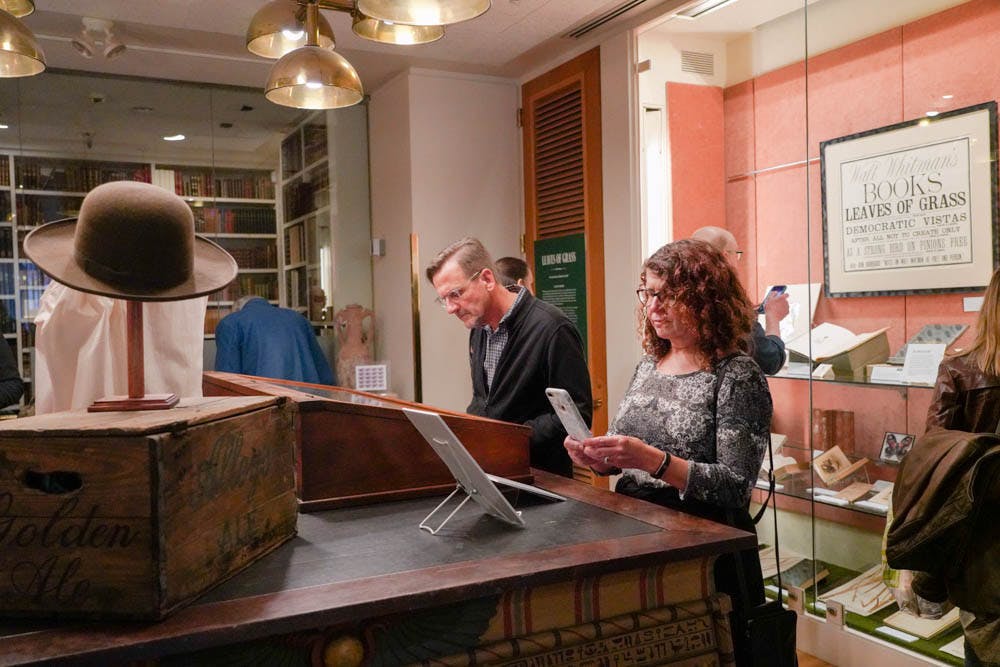In honor of the 200th anniversary of Walt Whitman’s birth, “Poet of the Body,” an exhibit featuring the first edition of “Leaves of Grass,” opened at the Providence Athenaeum Oct. 15. On Saturday, the Athenaeum hosted “A Walt Whitman Celebration” to highlight the great legacy of Whitman in literature, history and popular culture.
The Athenaeum’s “Poet of the Body” featured objects from a larger exhibit of the same title that was displayed earlier this year at the Grolier Club in New York City, not far from West Hills, New York, where Whitman was born and raised. Included in the exhibit are various editions of “Leaves of Grass” and rare photographs of Whitman, alongside personal artifacts like Whitman’s rings and a walking stick. A portion of the pieces in the exhibit are from the private Walt Whitman Collection of Susan Jaffe Tane.
The Athenaeum brings its own history with Whitman to the exhibition.
Walt Whitman visited Providence in October of 1868, describing the city as “this half-rural, brisk, handsome, New England, third-class town,” in a letter to his partner Peter Doyle. Whitman stayed on Congdon Street during his visit.
“Both of the people he stayed with were members of the library. So, it’s likely that he came (to the Athenaeum) when he visited,” said Robin Wetherill, director of membership and external relations at the Athenaeum.
“Very excitingly, we still have, in our collection, the first edition of ‘Leaves of Grass.’ What is special about ours is that it’s the first purchase by the library. …The copyright information is written by Whitman himself. It’s been part of our collection since 1858,” Wetherill said.
The Athenaeum still has the $1.25 receipt from when they first acquired “Leaves of Grass” from a Providence bookseller. “It was unusual in so many different ways, from the size of the book to the fact that there’s no author on the title page, that the only indication of the author was this very casually posed portrait,” said Kate Wodehouse, the curator and director of collections at the Athenaeum.
Alongside detailing Whitman’s ties to Providence, the exhibition also aims to present him as an active “master of self-promotion,” said Wodehouse.
For example, Wetherill described how Whitman praised himself as “an American bard at last” and utilized new technology to promote his work. “He understood the power of imagery. He was securing his legacy by having himself photographed a lot,” Wetherill said.
“He wanted his poetry to be reflective of sort of democratic ideals and inclusiveness, and to sort of heal the country as it was heading towards war,” Wodehouse said. During the Civil War, Whitman “worked as a clerk during the day, and then would tend to soldiers during the evening. … He would write letters to their families for them, bring them anything that would give them some sense of comfort,” Wetherill added.
Whitman is also known for having a nearly life-long relationship with Peter Doyle, a streetcar conductor. Whitman associated the plant Calamus with same-sex love and attraction. He named one of the clusters of poems in “Leaves of Grass” after Calamus, celebrating the “manly love of comrades,” he wrote in a poem.
“Though some of his writings are controversial, in the first edition of ‘Leaves of Grass,’ he’s calling for the equal society. ... So it’s really a celebration of people on an equal playing field in a way that (there) hadn’t been before in the US,” said Wetherill.
“I really enjoy this exhibition, that you can bring everything to life in a way,” said Tom Ash, a local resident who visits the Athenaeum often to read and attend literary events.
“It’s my first time visiting the Athenaeum,” said Ronald Yuan ’23. “It’s very neat. … I haven’t read Whitman but am planning to read some of his poems.”
Juli Anna Herndon, the executive assistant at the Athenaeum, also expressed her enthusiasm about the exhibit and the audience it draws to the Athenaeum. “We have a lot of communities that are very engaged, I feel really blessed to be a part of that,” she said.
The celebration of Whitman will continue Oct. 25 with a talk from Whitman scholar and NYU professor Karen Karbiener. “Poet of the Body” will be showing at the library until Jan. 5.
Correction: A previous version of this article stated that Walt Whitman was born and raised in New York City. In fact, he was born and raised in West Hills, New York. The article has been updated to reflect that change. The Herald regrets the error.





